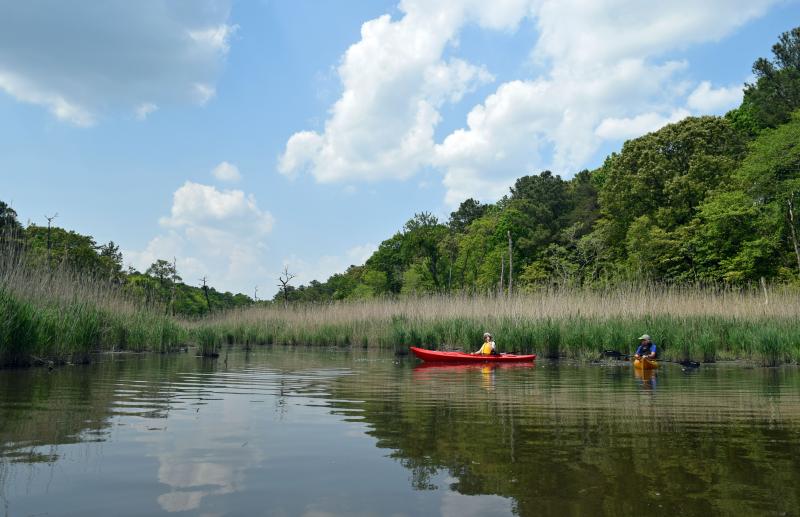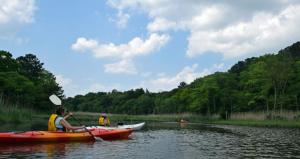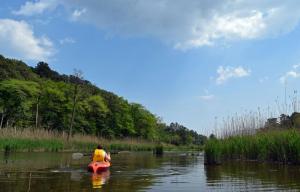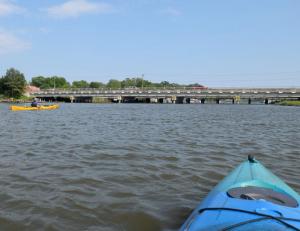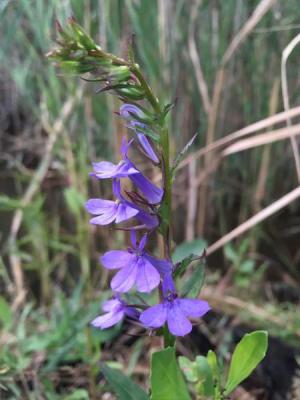Sussex at Crossroads: Can we protect watershed, allow growth?
State officials say the Love Creek Natural Area is a significant state resource where development should be avoided.
But a pending request to upzone a 124-acre parcel known as the Dorman Farm along the creek’s Hetty Fisher Glade tributary would pave the way for Belle Terre, a 378-unit proposed development, partially in the natural area.
BELLE TERRE HEARING
Sussex County Council will hold a public hearing on the Belle Terre rezoning request Tuesday, June 28, in council chambers in Georgetown.
Developer Sussex Real Estate Partners LLC wants to rezone a 124-acre parcel from AR-1, agricultural-residential, to MR-RPC, medium-density-residential-planned community, for a 124-acre parcel on Dorman Farm Lane southwest of Mulberry Knoll Road. The preliminary site plan for the proposed Belle Terre community shows 378 units – 200 single-family lots and 178 duplexes.
In 2006, state environmental officials mapped land along the Rehoboth Bay tributary, designating nearly 1,000 acres around Love Creek as an official natural area because of its significant ecological, geological or archeological importance. The parcel slated for development includes about 50 acres of designated natural area.
Experts to study source of bacteria in Love Creek
By Maddy Lauria
In fall 2015, the Delaware Center for the Inland Bays released a citizen-science based report on the health of Love Creek, which found high levels of enterococcus in the waterway. Enterococcus bacteria is found in fecal matter and can cause digestion-related illness in people.
On May 27, the center's Board of Directors voted to request that the state Department of Natural Resources and Environmental Control launch a study to identify the source of the enterococcus.
The report, developed by a volunteer team, also found there are more than 1,300 septic systems in the 24-square-mile Love Creek watershed, with an average of 55 active septic permits per square mile.
DNREC's DNA sourcing project will identify whether the enterococcus is coming from human sources or other animals, such as gulls, cows, dogs or chickens.
Plans for a second proposed development, the 100-lot Dellman Estates, also call for disturbing land in the Love Creek Natural Area.
Landowners can protect a designated natural area permanently, with a conservation easement or nature preserve, but the process is voluntary, said state Department of Natural Resources and Environmental Control natural areas program manager Eileen Butler.
“The natural areas program was meant to identify lands that were ecologically important and give the landowner an opportunity to legally protect them in perpetuity,” Butler said.
In New Castle County, a natural areas ordinance in the county’s land-use development code designates levels of protection for these areas, depending on their importance, and places restrictions on development, such as limiting how much forest can be removed.
That’s not the case in Sussex County.
“When we tell the county something is in the natural areas program, there is no regulation associated with it,” Butler said. The designation is just a recommendation to protect the land, she said.
“We don’t have regulations with this program, so we try to work with the developer,” she said. “We write comments all the time, and we hope that they consider those comments. In Sussex County, there’s not a high level of success.”
In the case of the controversial Love Creek RV Park and Campground, county officials did deny a zoning change and conditional-use request to build the project on more than 160 acres of land, nearly all of which was within the Love Creek Natural Area. Despite the zoning change rejection in 2014, other development options for the site may still be considered.
Delaware Center for the Inland Bays Executive Director Chris Bason says development of the natural area along Love Creek could be devastating for wildlife, and worse, could seal the fate of the estuary.
He said his organization aims to do the exact opposite: Restore forests and improve buffers lining the Inland Bays.
The Love Creek Natural Area is home to extensive woodlands, which Bason and Butler said are diminishing in eastern Sussex County. Wetlands, seasonal ponds and upland habitats in the area are inhabited by rare amphibians and plants, and by more common species.
During an April 28 Sussex County Planning and Zoning Commission public hearing, the Dorman Farm developer’s attorney, Jim Fuqua, said the rare species mentioned by state officials in a review of the project – the Eastern tiger salamander, barking tree frog and Cope’s gray tree frog – will not be adversely affected by the development.
“There are no endangered species or species of concern on or near this site, so there will be no adverse impact on any species,” said Fuqua, who could not be reached for further comment.
The three amphibians recognized as rare species by the state rely on the Love Creek Natural Area’s seasonal ponds for breeding, as well as the uplands and wooded areas for habitat, said Anthony Gonzon, program manager for biodiversity with the state Division of Fish and Wildlife.
“These wetlands are host to a variety of other species as well, some rare, some not so rare,” he said.
Plans are in place to protect Hetty Fisher Glade and Hetty Fisher Pond with 60- to 140-foot forested buffers, the Dorman Farm developer’s environmental consultant Edward Launay said at the April hearing.
Developing the parcel, which includes 11 acres of wetlands, 55 wooded acres and 58 upland acres, includes the removal of 37 acres of forest, development plans show.
Bason said ignoring the natural area designation may come at a serious cost for wildlife that depends on the forests and other habitats, but also to the water quality of the creek, its tributaries and Rehoboth Bay.
“Love Creek is unique in that it has – right now, anyway – some extraordinary areas of forested buffer,” he said. “That’s kind of a rare thing. It’s a rare and beautiful habitat that’s under real threat from development right now. Some of the lands they’re proposing to develop are just full of rare species – and the Dorman property is one of them.”
Those forests use and hold nutrients, including nitrogen and phosphorus from fertilizers and runoff. Without forests, nutrients are more likely to pollute the creek and Rehoboth Bay; they can produce algal blooms, resulting in a loss of oxygen, and fish kills. Blooms also destroy vital nursery habitat for local fish, crabs and other aquatic species, Bason said.
Uncommon plants are also found along the creek, including flowering lobelia and underwater horned pond weed, which has been on a steady decline in the waterways of the Inland Bays. Upland habitats, riparian forests and coastal seasonal ponds found throughout the area are also vital to the life cycles of both rare and common species, Butler said.
“The riparian forest, that’s what’s connecting it all together, and that’s how species move around in the watershed,” Butler said. “If there’s a way we can work together to protect that watershed, that’s what this program is all about.”
Since the last program survey in 2006, more than 78,000 acres of natural area have been designated in Sussex County. To date, landowners have permanently preserved about 2,800 acres. Within the nearly 1,000-acre Love Creek Natural Area, the only land that is protected is part of dedicated open space in the Ridings at Rehoboth, Caldera Coastal Club, Retreat at Love Creek and Harts Landing developments, Butler said.
Bason said protecting ecologically important habitats is not only critical for rare species. It’s the only way to keep common species common, he said.
“Whenever you have those small populations, and they’re dispersed out across a wide landscape and you destroy part of that landscape, it cumulatively destroys the ability of that population to sustain itself,” he said. “You lose that piece of the biodiversity puzzle. So do we protect our biodiversity, our natural heritage, or do we continue to build developments? It’s a social choice.”
Migratory songbirds and shorebirds depend on migration corridors like the forests found along Love Creek, and area fish and crabs require clean water in Inland Bays tributaries for nursery habitats.
“It’s not just about the rare species. It’s about keeping the common species common and just leaving some of the beautiful woods we have had around the Inland Bays,” Bason said. “Biodiversity is a local thing, and it’s something to cherish and protect.”
Bason said Love Creek is stressed by high levels of nutrients and bacteria, in part because Sussex County fails to require wide buffers along waterways.
“There’s science that is decades old that shows as you convert forest to other land uses, it degrades water quality in the estuary. That’s just what happens,” Bason said. “And the closer that forest is to the water, the more severe those impacts are.”
Gonzon said both the rare and common species found in the Love Creek Natural Area rely on those specific, sensitive habitats.
“We always consider any area that really does benefit the wildlife resources in this state to be important,” Gonzon said. “Wildlife resources are a part of our natural heritage and part of everyday lives for a lot of Delawareans. If you care about those resources, it’s important to care about any place that harbors rare or unique species or common species as well.”
In the Belle Terre preliminary land-use service report, state officials noted the importance of preserving habitat along Love Creek and urged developers to limit disturbance to agricultural fields on site and leave the forest intact.
“There are only four metapopulations of barking tree frog (also state-endangered) known on the entire Delmarva Peninsula, one of which would likely be eliminated as a result of this project,” the report states. “There are other state-rare species on the site that will also be affected by the disturbance to the uplands and coastal plain seasonal ponds.”
But those recommendations have no regulatory power, Bason said.
“If you keep this up, you’re sealing the fate of the estuary,” he said. “I don’t know what else to say. It’s just the truth. And if people want it to stop, people have to do something about it.”














